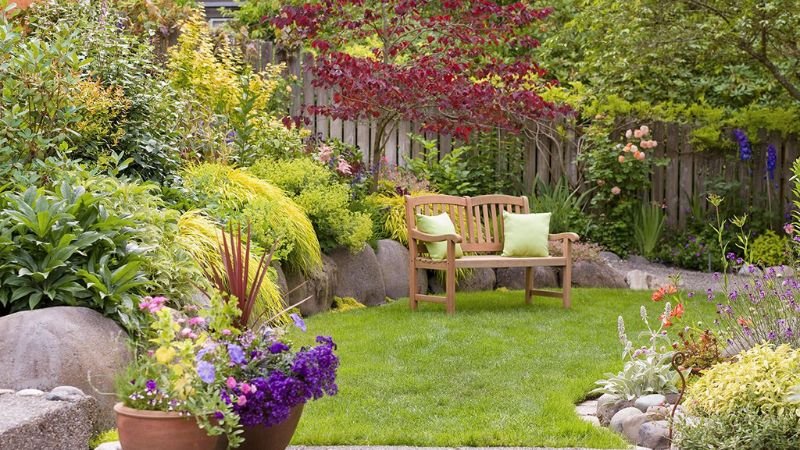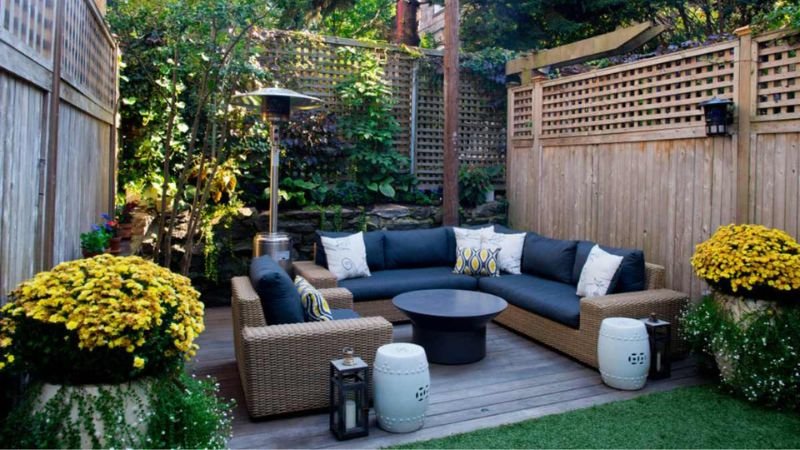Transforming a sloped garden into a stunning landscape can be a rewarding project with the right ideas and techniques. Sloped gardens offer unique challenges, but they also present exciting opportunities to create eye-catching designs and functional spaces. Whether you’re looking to enhance your garden’s visual appeal or improve its usability, implementing creative hillside landscaping ideas can make a significant difference.
From terracing and creating pathways to incorporating retaining walls and native plants, there are various strategies to optimize your sloped garden. This blog explores 11 innovative hillside landscaping ideas that will help you turn your sloped garden into a beautiful, practical outdoor space.
11 Hillside Landscaping Ideas For A Sloped Garden
1. Create Terraced Gardens
Terracing is a highly effective way to manage a sloped garden. By creating a series of flat, horizontal sections, you can transform a steep incline into a series of manageable planting areas. Each terrace can be used for different purposes, such as growing vegetables, flowers, or shrubs. Terraces help in controlling soil erosion and water runoff by slowing down the flow of rainwater.
Additionally, they provide opportunities for creating distinct garden zones, making your garden more functional and visually appealing. You can build terraces using materials like timber, stone, or concrete, depending on your budget and aesthetic preferences.
Also Read:- How To Design A Pet Friendly Garden
2. Install Retaining Walls
Retaining walls are essential for holding back soil and preventing erosion in a sloped garden. They can be constructed from various materials, including brick, stone, or concrete, and can be used to create level areas for planting or patio spaces. Retaining walls not only add a structural element to your garden but also enhance its overall appearance. They can be designed to blend with the natural landscape or to stand out as a focal point. Incorporating features like built-in planters or seating areas into your retaining walls can add functionality and aesthetic value.
3. Design Pathways and Steps
Incorporating pathways and steps into your sloped garden can make it more accessible and visually engaging. Pathways can be made from materials like gravel, paving stones, or timber, and should follow the natural contours of the slope. Steps can be constructed from the same materials or from durable, non-slip options like concrete. Adding pathways and steps not only improves the usability of your garden but also provides a way to explore different areas easily. Consider integrating lighting along pathways for safety and ambiance during the evening.
4. Utilize Ground Cover Plants
Ground cover plants are perfect for covering large areas of a sloped garden and preventing soil erosion. These slow-growing plants quickly cover the ground, creating a thick mat that aids in soil stabilization. Options like creeping thyme, sedum, and clover are excellent for hillside gardens. Ground cover plants also add a lush, green layer to your landscape, reducing the need for mulch and lowering maintenance. Choose plants that are well-suited to your climate and soil conditions to ensure they thrive and effectively cover the slope.
5. Incorporate Rock Gardens
Rock gardens can be a stunning addition to a sloped garden, adding texture and visual interest. By using large rocks, boulders, and gravel, you can create a natural-looking landscape that complements the slope of your garden. Rock gardens are also low-maintenance and can help with soil erosion by stabilizing the ground. You can plant hardy, drought-tolerant plants among the rocks to enhance the garden’s appearance. Rock gardens work particularly well in dry or arid climates where traditional planting might be challenging.
6. Create a Water Feature
Adding a water feature, such as a small pond, waterfall, or stream, can enhance the ambiance of a sloped garden. Water features not only provide a soothing sound but also attract wildlife and add visual interest. The natural flow of water can be used to navigate through different levels of the garden or create a focal point. When designing a water feature, ensure it integrates seamlessly with the slope and surrounding landscape. Proper installation and maintenance are key to preventing issues like water stagnation or erosion.
7. Install Raised Beds
Raised garden beds are a practical solution for managing a sloped garden and can be used for growing vegetables, herbs, or flowers. By elevating the planting area, you can improve soil drainage, reduce weed growth, and make gardening easier on your back. Raised beds can be constructed from various materials, including wood, stone, or metal. They can be arranged in a tiered fashion to follow the slope of the garden or placed strategically to create level planting areas. Adding mulch or ground cover around the beds can further help with erosion control.
8. Incorporate Steps with Built-in Seating
Steps with built-in seating are a stylish and functional addition to a sloped garden. They provide a place to rest while also allowing you to navigate the slope more easily. Built-in seating can be made from materials like timber, stone, or concrete and can be integrated into retaining walls or terraced areas. This feature not only adds a practical element but also creates a focal point for gatherings or relaxation. Choose durable materials and comfortable designs to enhance the overall enjoyment of your garden space.
9. Add Drystone Walls
Drystone walls are a traditional and visually appealing option for hillside landscaping. These walls are built without mortar, using carefully selected stones to create a stable structure. Drystone walls are ideal for sloped gardens as they provide excellent erosion control and blend well with natural landscapes. They can be used to create terraced areas, define garden spaces, or serve as attractive garden features. The gaps between the stones can also be planted with small, hardy plants to enhance the wall’s appearance and functionality.
10. Use Native Plants
Incorporating native plants into your sloped garden is an environmentally friendly approach that supports local ecosystems and reduces maintenance. Native plants are adapted to the local climate and soil conditions, making them more resilient to changes and less reliant on additional watering or fertilization. They also provide habitat for local wildlife and can enhance the natural beauty of your garden. When selecting native plants, consider factors like sunlight, soil type, and the specific conditions of your slope to ensure successful growth and integration.
Also Read:- How To Start a Native Plant Garden
11. Create an Outdoor Living Space
Transforming part of your sloped garden into an outdoor living space can make it a more enjoyable and functional area. This could include a deck, patio, or pergola, where you can relax and entertain guests. Position the living space to take advantage of the best views and create a level area using decking or paving. Adding comfortable furniture, outdoor lighting, and landscaping around the space can enhance its usability and aesthetic appeal. An outdoor living space can become a focal point in your garden, offering a retreat from everyday life.
Conclusion
By applying these 11 hillside landscaping ideas, you can effectively transform your sloped garden into a visually appealing and functional space. Each idea offers a unique approach to dealing with the challenges of a sloped area, ensuring you make the most of your garden’s potential. Whether you opt for terraced beds, decorative retaining walls, or lush ground cover, these landscaping techniques will enhance both the beauty and functionality of your garden. Embrace these ideas and watch your sloped garden evolve into a captivating outdoor retreat.
FAQs
What are the benefits of terracing a sloped garden?
Terracing helps manage erosion, creates flat areas for planting, and adds visual interest by breaking up the slope into manageable levels.
Can I use retaining walls in my hillside landscaping?
Yes, retaining walls are excellent for preventing soil erosion, creating usable space, and adding a structural element to your garden design.



